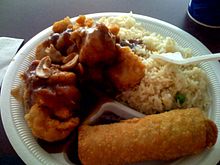Acombination meal,often referred as acombo-meal,[1]is a type of meal that typically includes food items and a beverage. They are a common menu item at fast food restaurants, and other restaurants also purvey them. Combination meals may be priced lower compared to ordering items separately, but this is not always the case. A combination meal is also a meal in which the consumer orders itemsà la carteto create their own meal combination.




Thecasadais a common type of lunch combination meal in Costa Rica and Panama.
Overview
editFast foodcombination meals typically include a main item (called entrée in American English, but not usually inFrench) such as a hamburger, a side dish such as fries, and a beverage such as a soft drink.[2]Other types of restaurants, such asfast-casual restaurantsalso offer combination meals.[3]
Combination meals may be priced lower compared to ordering the items separately, and this lower pricing may serve to entice consumers that are budget-minded.[2][4]A 2010 study published in theJournal of Public Policy & Marketingfound that some consumers may order a combination meal even if no price discount is applied compared to the price of ordering items separately.[3]The study found that this behavior is based upon consumers perceiving an inherent value in combination meals, and also suggested that the ease and convenience of ordering, such as ordering a meal by number, plays a role compared to ordering items separately.[3]This study also found that the presence of combination meals encourages consumers to increase meal portion size bysupersizingtheir meals.[3]
A combination meal can also comprise a meal in which separate dishes are selected by consumers from an entire menu, and can includeà la carteselections that are combined on a plate.[5]A fast food combination meal can contain over 1,300 calories (5,400 kJ).[6]Fast food restaurants sometimes offer a means to order larger portions of food within the format of the combination meal, such as supersizing.[7]
History
editIn the United States in the early 1930s, the combination meal was a popular dish in restaurants and in homes.[a]
In Latin America
editIn Costa Rican and Panamanian cuisine, a combination meal is referred to as acasado,which means "married".[9][10]It is a typical lunch dish in both countries.[9][10]In Costa Rica, acasadotypically consists of a meat dish, rice and beans, and deli salads.[9]Additional foods comprising the Costa Ricancasadocan include fried plantain, noodles and tomatoes.[11]In Costa Rica, the termplato del día(plate of the day) is frequently used interchangeably with the termcasado.[11]
In Panama, acasadotypically consists of an entree, rice and beans, and cabbage.[10]In Panama, theplato executive,which means "executive plate", is aprix fixe(fixed price) lunch menu offered in some upscale restaurants that is similar in concept to thecasado.[10]
In Spain
editThe Spanish version of the combination meal, known asplato combinado,is a staple in bars and restaurants across the country. These meals are popular as they are affordable and can be quickly cooked to order. They often consist of a main (meat, e.g.grilled steak,hamburgersorbreaded cutlets;seafood, e.g.fried calamarior grilled squid; fish, battered or grilled; or other fried foods, such ascroquettes), a side dish of salad or French fries (in some cases, mixed vegetables or peas), and afried egg.
The meals date back to theSpanish Civil War.During that period, theFrancoist dictatorshipintroduced a single-dish day (Día del Plato Único), which initially took place every fortnight and then each Friday, in order to support the war effort. However, most upscale restaurants circumvented the rule by increasing serving sizes or using ingredients in short supply, such as seafood, fish or fresh eggs.[12]In its current iteration, theplato combinadowas designed to cater to the increasing number of tourists during theSpanish miracle.To do so, the meals and their prices were normalised; in this way, the offerings would be consistent across the country. As the meal sets were not popular with tourists, the government began to promote them amongst the local population, where they were well received. This could be explained by their association with American-stylediners,which were fashionable in the 1950s and 1960s.[12]
Despite their popularity, theplato combinadois often seen as unhealthy and outdated. This is due to the cooking techniques used, as many of the products aredeep-fried.In addition, many of the products used tend to be lacking in quality, as they are mostly frozen.[13]In this sense, the fare is similar to that served in cafés orgreasy spoonsin the United States and the United Kingdom.
See also
editNotes
editReferences
edit- ^Dumanovsky, T., Nonas, C. A., Huang, C. Y., Silver, L. D. and Bassett, M. T. (2009)."What People Buy From Fast-food Restaurants: Caloric Content and Menu Item Selection, New York City 2007".Obesity.Volume 17. pp. 1369–1374. doi:10.1038/oby.2009.90
- ^abBlack, K. (2009).Business Statistics: Contemporary Decision Making.Wiley Plus Products Series. John Wiley & Sons. p. 266.ISBN978-0-470-40901-5.RetrievedJanuary 18,2017.
- ^abcd"Study: People choose combo meals regardless of value or size".fastcasual.November 28, 2010.RetrievedJanuary 18,2017.
- ^Ferrante, J. (2005).Sociology: A Global Perspective.Available Titles CengageNOW Series (in Spanish). Cengage Learning. p. 194.ISBN978-0-495-00561-2.RetrievedJanuary 18,2017.
- ^Food Technology in Australia.Council of Australian Food Technology Associations. 1980. Volume 32. p. 580.
- ^Nonas, C.; Foster, G.D.; Association, American Dietetic (2009).Managing Obesity: A Clinical Guide.American Dietetic Association. p. 196.ISBN978-0-88091-425-3.RetrievedJanuary 18,2017.
- ^Keller, K. (2008).Encyclopedia of Obesity.SAGE Publications. p. 259.ISBN978-1-4522-6585-8.RetrievedJanuary 18,2017.
- ^Wood, M.W.; Lindquist, R.; Studley, L.A. (1932).Managing the Home.Riverside home economics series. Houghton Mifflin. p. 218.RetrievedJanuary 19,2017.
- ^abcPenland, P.R. (2008).Explorer's Guide Costa Rica: With Excursions to Nicaragua & Panama: A Great Destination.Explorer's Great Destinations. Countryman Press. p. 32.ISBN978-1-58157-989-5.RetrievedJanuary 19,2017.
- ^abcdFodor's Travel Publications, I.S.; Kast, M.E.; Mattson, S.; Van Fleet, J. (2010).Fodor's Panama, 2nd Edition.Fodor's Panama. Fodors Travel Pub. p. 20.ISBN978-1-4000-0429-4.RetrievedJanuary 18,2017.
- ^abKelly, M. (2007).Costa Rica 2008.Fodor's 2008. Fodor's Travel Publications. p.455.ISBN978-1-4000-1803-1.RetrievedJanuary 19,2017.
- ^abValdivieso, Marta (May 7, 2016)."El plato combinado nació en la Guerra Civil".elespanol.RetrievedJuly 29,2020.
- ^Taboada, Lucía (February 26, 2016)."La inmortalidad del plato combinado".elcomidista.elpais.RetrievedJuly 29,2020.
Further reading
edit- "Not so happy meal: Fast food combos take a beating".Fortune.July 1, 2012.RetrievedJanuary 18,2017.
- Bomkamp, Samantha (May 5, 2016)."Burger chains see payoff from combo meal deals".Chicago Tribune.RetrievedJanuary 18,2017.
- "Kids' consumption of high-calorie drinks at fast-food restaurants tied to combo meals".NYU Langone Medical Center.October 7, 2016.RetrievedJanuary 18,2017.